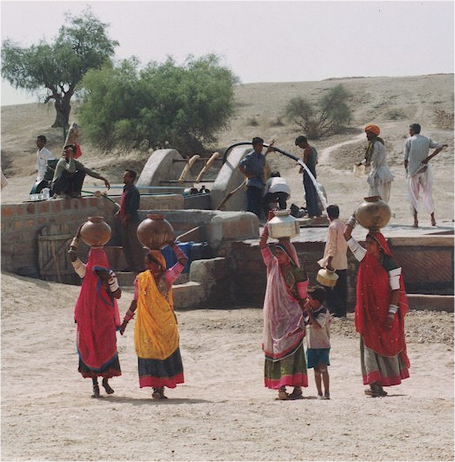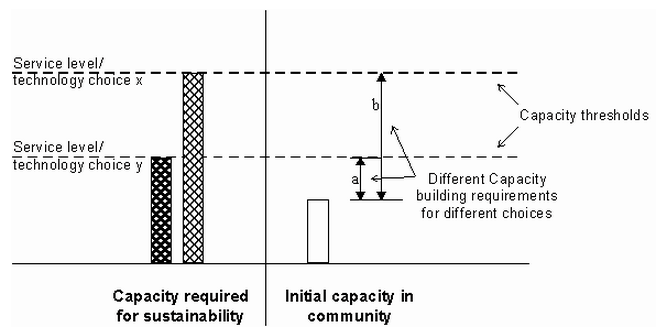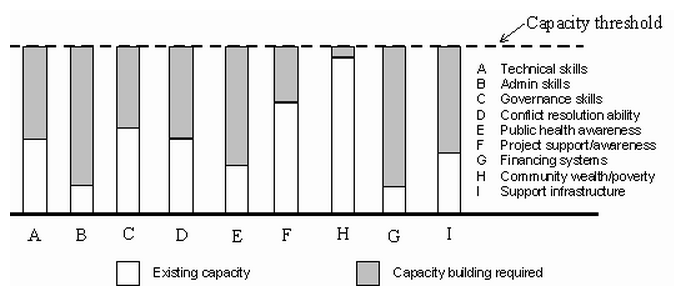Difference between revisions of "Capacity Building - Threshold Concept"
(Published from sandbox) |
|||
| Line 1: | Line 1: | ||
| − | [[File:Capacity photo.jpg|thumb|right|200px|Building Local Capacity to Construct Safe Low Cost Latrines. Photo:]]Capacity building includes a broad definition as a holistic enterprise, encompassing a multitude of activities. It means building abilities, relationships and values that will enable organisations, groups and individuals to improve their performance and achieve their development objectives. It includes strengthening the processes, systems and rules that influence collective and individual behaviour and performance in all development endeavours. It means enhancing people’s technical ability and willingness to play new developmental roles and adapt to new demands and situations. Capacity building is not only constrained to officials and technicians but must also include the general awareness of the local population regarding their services and development in general. | + | [[File:Capacity photo.jpg|thumb|right|200px|Building Local Capacity to Construct Safe Low Cost Latrines. Photo credit: coming soon]]Capacity building includes a broad definition as a holistic enterprise, encompassing a multitude of activities. It means building abilities, relationships and values that will enable organisations, groups and individuals to improve their performance and achieve their development objectives. It includes strengthening the processes, systems and rules that influence collective and individual behaviour and performance in all development endeavours. It means enhancing people’s technical ability and willingness to play new developmental roles and adapt to new demands and situations. Capacity building is not only constrained to officials and technicians but must also include the general awareness of the local population regarding their services and development in general. |
<div><br/></div><div><div>Capacity building is needed at different levels for the different actors, improving performance and coordination between them. Of the many frameworks out there, a few key elements of capacity building are identified here :</div><div><br/></div> | <div><br/></div><div><div>Capacity building is needed at different levels for the different actors, improving performance and coordination between them. Of the many frameworks out there, a few key elements of capacity building are identified here :</div><div><br/></div> | ||
*'''Human resource development:''' enhancing knowledge, skills and capacities of individuals in technical, personal and managerial areas. | *'''Human resource development:''' enhancing knowledge, skills and capacities of individuals in technical, personal and managerial areas. | ||
| Line 10: | Line 10: | ||
=== Capacity thresholds === | === Capacity thresholds === | ||
<div>For a given service to be sustainable in a given location, the requirements of each of these categories can, to a large degree, be pre-determined. These represent the thresholds which are required in order for the service to the sustainable. In any particular community a certain level of capacity will exist in each of the categories. Where this capacity is less than the threshold capacity required for sustainability, capacity building will need to be undertaken to ensure that the threshold is reached. The threshold in all categories must be achieved in order to ensure sustainability. For example, if all other thresholds are reached but community acceptance is lacking, revenue will be difficult to collect which may result in the failure of the scheme.</div> | <div>For a given service to be sustainable in a given location, the requirements of each of these categories can, to a large degree, be pre-determined. These represent the thresholds which are required in order for the service to the sustainable. In any particular community a certain level of capacity will exist in each of the categories. Where this capacity is less than the threshold capacity required for sustainability, capacity building will need to be undertaken to ensure that the threshold is reached. The threshold in all categories must be achieved in order to ensure sustainability. For example, if all other thresholds are reached but community acceptance is lacking, revenue will be difficult to collect which may result in the failure of the scheme.</div> | ||
| − | [[File:Cap threshold.png|thumb|none|550px|The amount of capacity building required for a given category will depend on 2 factors: the level of capacity already within the community, and the level of service and the technology chosen. Diagram:]] | + | [[File:Cap threshold.png|thumb|none|550px|The amount of capacity building required for a given category will depend on 2 factors: the level of capacity already within the community, and the level of service and the technology chosen. Diagram credit: coming soon]] |
<br/> | <br/> | ||
| Line 18: | Line 18: | ||
During the feasibility phase of a project, a participative evaluation process needs to be undertaken with the community to establish the levels of capacity which exist prior to the project. The service level options and technology choices must be established so as to be able to identify the thresholds which the community must meet in each category in order to ensure sustainability. | During the feasibility phase of a project, a participative evaluation process needs to be undertaken with the community to establish the levels of capacity which exist prior to the project. The service level options and technology choices must be established so as to be able to identify the thresholds which the community must meet in each category in order to ensure sustainability. | ||
| − | [[File:Cap threshold2.png|thumb|none|550px|Diagram:]] | + | [[File:Cap threshold2.png|thumb|none|550px|Diagram credit: coming soon]] |
<div>The feasibility phase should not only address the technical feasibility of different options for services. The institutional, economic and social feasibility should also be assessed. This can be done using a threshold methodology. If any category of capacity within the community is not likely to be able to be raised to the threshold required for a particular service/technology choice, then that choice will not be sustainable. The only option is to lower the threshold by choosing a lower level of service or technology. The most obvious example would be the level of wealth/ poverty in a community which determines whether the community could afford to pay the recurring costs of the proposed scheme.</div><div><br/></div><div>Affordability and the will to pay need careful consideration. A given low level of service may be affordable to the community but if it is not acceptable or supported by the community there will not be the will to pay. Experience has indicated that often a higher level of service is more sustainable than a lower level because people are prepared to pay for the higher but not the lower service.</div><div><br/></div><div> | <div>The feasibility phase should not only address the technical feasibility of different options for services. The institutional, economic and social feasibility should also be assessed. This can be done using a threshold methodology. If any category of capacity within the community is not likely to be able to be raised to the threshold required for a particular service/technology choice, then that choice will not be sustainable. The only option is to lower the threshold by choosing a lower level of service or technology. The most obvious example would be the level of wealth/ poverty in a community which determines whether the community could afford to pay the recurring costs of the proposed scheme.</div><div><br/></div><div>Affordability and the will to pay need careful consideration. A given low level of service may be affordable to the community but if it is not acceptable or supported by the community there will not be the will to pay. Experience has indicated that often a higher level of service is more sustainable than a lower level because people are prepared to pay for the higher but not the lower service.</div><div><br/></div><div> | ||
Revision as of 01:46, 16 November 2013
Capacity building includes a broad definition as a holistic enterprise, encompassing a multitude of activities. It means building abilities, relationships and values that will enable organisations, groups and individuals to improve their performance and achieve their development objectives. It includes strengthening the processes, systems and rules that influence collective and individual behaviour and performance in all development endeavours. It means enhancing people’s technical ability and willingness to play new developmental roles and adapt to new demands and situations. Capacity building is not only constrained to officials and technicians but must also include the general awareness of the local population regarding their services and development in general.- Human resource development: enhancing knowledge, skills and capacities of individuals in technical, personal and managerial areas.
- Organisational development: improving organisational performance, management, systems and governance in order to build effective, efficient and accountable institutions.
- Institutional development: strengthening interrelationships between stakeholders, strengthening cooperation and coordination, clarifying tasks, roles and terms of interaction.
- Economic factors and support infrastructure: Revenue flow to cover the recurring cost of maintenance, operating expenses, salaries and the repayment of loans if applicable. Support infrastructure consisting of such things as office accommodation, transport, communications, electricity, or copying facilities.
The capacity required for sustainability is determined not only by the level of service chosen by the community but more importantly by the technology choice made to provide that level of service. For example, if a community chooses a household connection level of service this could be achieved through a number of alternative technology options. The service could be provided by developing boreholes or by the construction of a gravity fed system or through purchasing water from a regional scheme. Each of these technology options would provide the same level of service to the community but each would require different skills and "capacities" in the community or local government.
Capacity thresholds
Applying the Threshold Concept
During the feasibility phase of a project, a participative evaluation process needs to be undertaken with the community to establish the levels of capacity which exist prior to the project. The service level options and technology choices must be established so as to be able to identify the thresholds which the community must meet in each category in order to ensure sustainability.
Planning and costing capacity building interventions

Implementing a capacity building programme
Monitoring and evaluation
Operation and maintenance capacity
Acknowledgements
- Len Abrams. Capacity Building for water supply and sanitation development at local level. A paper delivered at the 2nd UNDP Symposium on Water Sector Capacity Building, Delft, Netherlands. The African Water Page.
- Donald Kaniaru, Xia Kunbao; Strike Mkandla; Levis Kavagi, Capacity Building for Sustainable Development: An overview of UNEP environmental capacity development initiatives. UNEP Division of Enviromental Policy Implementation. December 2002.
- FIETS sustainability approach. Dutch WASH Alliance.



